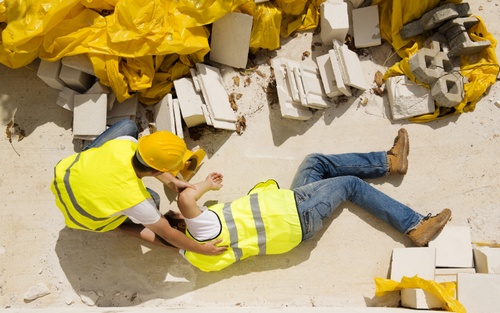Protect Yourself from Fall Hazards in the Workplace
A fall hazard is any risk of injury involving above-ground, multi-level duties, or hazards on the job site that make workers prone to trips, slips or falls. Falls are dangerous and a frequent cause of fatal injuries, hospital trips, and worker’s compensation payouts. While fall hazards are present nearly everywhere, those working in industrial, construction, and tower-climbing jobs should be extra mindful.
The most cited OSHA violation in the U.S. is fall protection compliance. In fact, the Bureau of Labor Statistics reported 5,190 fatal injuries resulting from fall hazards in 2021. Some job sites require employees to work six feet or higher in almost any industry, making the threat of fall hazards seemingly unavoidable. Whether you work on a construction site or climb towers, you should be mindful of these hazards to prevent injuries. Through awareness, training and the proper PPE, you can protect yourself and other workers while working at heights.
Be Aware of Your Environment
Always be aware of fall hazards in your work environment. You can protect yourself by being proactive about fall prevention as an employee in industrial, construction and tower-climbing industries. Hazards hide in places like:
- Loose or falling objects: Being struck by a loose or falling object can result in fatal injuries. It can happen in a second, and it is never predictable. Be aware of the risks while walking on working surfaces, and come prepared by wearing a hard hat and tool lanyards.
- Skylights: The safety of skylights is often overlooked. There is a great risk of fall hazards because floor holes are not always visible from them, they may not be secure in holding a worker, and they often lack protective barriers or guardrails. Workers should practice fall hazard prevention around skylights through regular inspection, implementation of protective barriers or safety nets, and the use of personal fall arrest systems.
- The weather: Some environmental fall hazards are completely outside of our control. While you can wear a hard hat or build a guardrail, you can’t change the weather. High winds and rainstorms can make it challenging to maintain balance when working on an elevated surface. Keep yourself informed on the weather and address risky conditions by inspecting equipment and using proper fall arrest harnesses and lanyards.
Other Fall Hazards
Fall hazards might also present themselves the following:
- Slippery, unstable, or cluttered walking and working surfaces, unprotected edges, floor holes and wall openings, poorly positioned ladders, and misused fall protection
- As a construction worker, you’ve likely had your fair share of unloading or working on top of trailers. While this everyday task might not seem very daunting or high up, fall hazard protection protocols should still be in place. Be sure to use guardrails and personal fall arrest systems like harnesses or lanyards when working on top of a trailer.
- Articulated boom trucks also pose a combination of upfront and hidden fall hazards. The risk of a fall fluctuates with equipment conditions. Because of this, equipment should be inspected regularly to ensure it is in good working condition or to identify and correct any potential fall hazards. An uneven ground surface or bad weather can disrupt your balance, so wear the proper personal fall arrest systems.
- Since their main purpose is to access materials on elevated platforms or mezzanines, scaffolding and pallet gates pose serious fall hazards that may result in fatal injuries. Loose bolts, worn parts, and faulty assembly indicate improper scaffold construction and can contribute to instability. Always inspect the structure beforehand, wear proper protective equipment, and install safety nets.
Use Harnesses Properly
It is important to wear the right type of fall protection equipment, including harnesses. Wearing a harness might give you peace of mind and security, but it is only effective if used properly. This type of personal protective equipment (PPE) requires proper training and continuous practice as well as inspection of potential damage before each shift. Safety harnesses should also meet ANSI and OSHA standards for maximum fall hazard prevention.
Part of properly using a harness also involves inspecting anchor points. Anchor points support the weight of the worker attached to the harness. These points should be regularly inspected to ensure proper attachment, reliability, and fall hazard protection.
Avoid Distractions
Let’s face it: distractions are everywhere. Simple acts like checking your phone or having a conversation with a co-worker can take away from the task at hand. Staying focused and avoiding distractions are important to uphold workplace safety and get the job done. You can’t approach fall hazards with an “it’s not going to happen to me” attitude. Accidents can happen, so remain alert and aware of potential hazards as some can be less noticeable than others.
Our goal at PK Safety has always been to ensure everyone gets home safely at the end of a day of work or play. This means providing the tools and safety equipment expertise you need to do your job and stay safe while doing it, even in a medical emergency. Minutes, or even seconds, can make a difference when saving a life. If you have any workplace safety questions, contact one of our safety experts online or by calling 800.829.9580.
Recent Posts
-
The Best Cold Weather Gloves for Package Handlers and Delivery Drivers | PK Safety
Best Gloves for Package Handlers During the Holiday Season As the holiday season approaches, pa …Nov 11th 2024 -
Why Hi-Vis Winter Work Gear is Essential for Safety During the Cold Months | PK Safety
When temperatures drop and daylight hours shrink, outdoor workers face additional hazards that incre …Oct 31st 2024 -
Self Braking Descender: Advanced Rope Control for Fall Protection | PK Safety
For professionals working at heights, controlled descent is critical. Whether you’re a window cle …Oct 30th 2024





